Pho, the beloved Vietnamese noodle soup, is renowned for its unique fragrance and taste. It has captured the hearts of food enthusiasts worldwide with its comforting flavors and complex broth. What sets pho apart from other soups is the combination of secret ingredients that give it its distinct character. In this article, I will reveal the traditional pho ingredients and the secrets behind creating an authentic pho recipe.
- Pho is a Vietnamese noodle soup known for its unique fragrance and taste.
- There are secret ingredients that make pho special, such as star anise, cinnamon, charred ginger and onion, beef bones, and fish sauce.
- Additional ingredients like dried shrimp, dried squid, daikon, cabbage, and chayote can enhance the flavor of pho.
- Pho broth requires the right combination, proportion, and technique to achieve the perfect flavor.
- Pho can be made with variations such as beef and chicken, and is served with rice noodles and various toppings.
The Key Spices: Star Anise and Cinnamon
The secret spices that form the backbone of pho’s complex flavor are none other than star anise and cinnamon. These two aromatic ingredients are the key to creating the distinctive taste that makes pho so unique.
Star anise, with its beautiful star-shaped pods, infuses the broth with a subtle licorice flavor, adding depth and complexity to the overall taste profile. Its warm and sweet notes are perfectly balanced by the earthiness of cinnamon, which lends a warm and cozy aroma to the soup. Together, star anise and cinnamon create a harmonious blend of flavors that tantalize the taste buds and leave a lasting impression.
When simmered with the beef bones and other ingredients, star anise and cinnamon release their essence, infusing the broth with their fragrant and comforting qualities. As the broth simmers slowly, the spices work their magic, resulting in a rich and aromatic base for the pho.

Pho lovers often marvel at the complexity and depth of flavor in a good bowl of pho, and the secret lies in these hidden elements – star anise and cinnamon. These spices elevate the broth to new heights, transforming a simple noodle soup into a culinary masterpiece.
Table 1: The Role of Star Anise and Cinnamon in Pho
| Ingredient | Characteristics |
|---|---|
| Star Anise | Subtle licorice flavor, warm and sweet notes |
| Cinnamon | Warm and cozy aroma, earthy undertones |
Charred Ginger and Onion: The Flavor-Building Elements
Another secret to the tantalizing flavor of pho lies in the process of charring ginger and onion. This technique involves exposing these ingredients to open flame, causing them to blacken and release their natural oils and sugars. The result is a deep, smoky flavor that adds complexity and richness to the broth.
The charred ginger and onion serve as flavor-building elements, enhancing the overall taste profile of pho. As they simmer in the broth, their essence infuses into every spoonful, lending a distinctive aroma and depth of flavor. It is this careful attention to detail that elevates pho from a simple noodle soup to a culinary masterpiece.
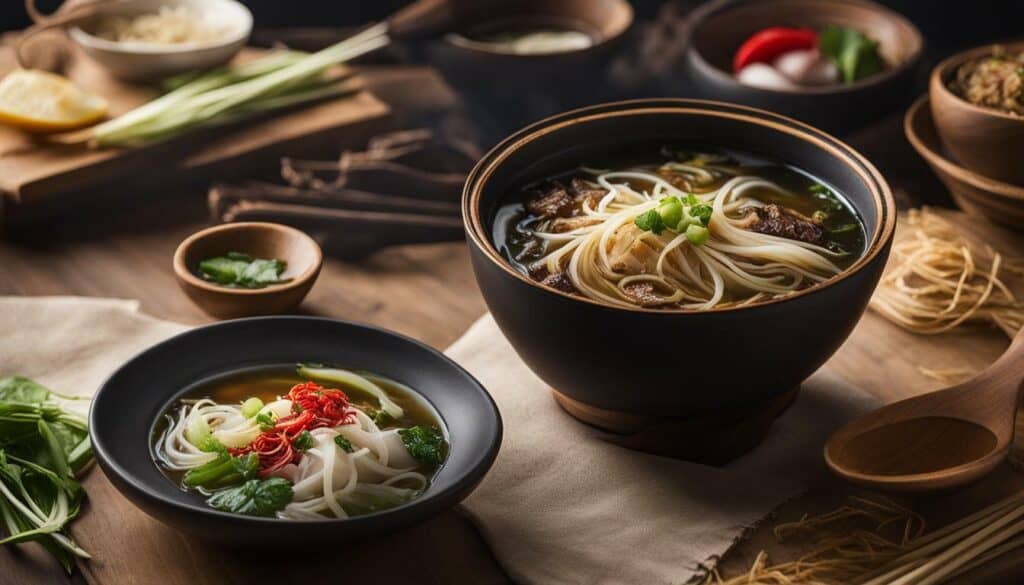
In Vietnamese cuisine, charring ginger and onion is a time-honored technique that is believed to unlock the full potential of these ingredients. The charred flavors meld seamlessly with the other secret ingredients in pho, creating a harmonious blend of tastes that is both comforting and complex.
The art of making pho lies in the balance and combination of these secret ingredients. Each element plays a crucial role in developing the unique flavor profile that has made pho a beloved dish around the world. Whether it’s the warm sweetness of star anise, the subtle spiciness of cinnamon, or the smoky depth of charred ginger and onion, every ingredient in pho contributes to its overall allure.
Table: Ingredients for Making Pho
| Secret Ingredients | Additional Flavor Enhancers |
|---|---|
| Star Anise | Vietnamese Dried Shrimp |
| Cinnamon | Dried Squid |
| Charred Ginger | Daikon |
| Charred Onion | Cabbage |
| Beef Bones | Chayote |
| Fish Sauce |
As you savor a bowl of pho, take a moment to appreciate the hidden elements that make it truly special. From the charred ginger and onion to the blend of spices and aromatics, each ingredient has been carefully selected to create a symphony of flavors. Pho is more than just a soup—it’s a culinary journey that delights the senses and leaves a lasting impression.
The Essence: Beef Bones and Fish Sauce
The backbone of pho’s savory essence is formed by using beef bones and fish sauce. These two ingredients work together to create a rich and flavorful broth that is the foundation of this beloved Vietnamese dish. The beef bones, typically a combination of marrow and knuckle bones, are simmered for several hours, allowing their flavors to infuse into the broth. This slow-cooking process extracts all the natural goodness from the bones, resulting in a deep, umami-packed liquid that forms the base of pho.
To further enhance the taste, fish sauce is added to the broth. Fish sauce, a staple in Vietnamese cuisine, is made from fermented fish and salt. It adds a unique depth of flavor and umami richness to the pho broth. The fish sauce perfectly complements the beef bones, creating a harmonious balance that makes pho so distinctive.
The combination of beef bones and fish sauce is a well-guarded secret in pho-making, passed down through generations. It is the careful selection and proportioning of these ingredients that give pho its irresistible aroma and taste.
| Key Ingredients | Role in Pho |
|---|---|
| Beef Bones | Provide the base flavor and richness in the broth. |
| Fish Sauce | Enhances the umami profile and adds depth to the broth. |
Creating a delicious pho broth requires patience and skill. The simmering process allows the flavors to develop and meld together, resulting in a broth that is both comforting and complex. The careful balance of beef bones and fish sauce is essential to achieve the perfect umami taste that is characteristic of a well-executed pho.
Enhancing the Flavor: Vietnamese Dried Shrimp and Squid
To elevate the flavor profile of pho, traditional recipes often include Vietnamese dried shrimp and squid. These ingredients add a distinct seafood undertone to the soup, enhancing its complexity and richness. The use of dried shrimp and squid in pho is a testament to the Vietnamese culinary tradition of incorporating various elements to create a harmonious balance of flavors.
The dried shrimp, known for its intense umami flavor, infuses the broth with a deep seafood essence that complements the other ingredients. Its unique taste adds depth and richness to the soup, creating a savory base that is both satisfying and tantalizing to the taste buds. When combined with the aromatic spices and charred ginger, the dried shrimp brings a unique and unforgettable flavor to every spoonful of pho.
Similarly, dried squid lends its distinctive taste and texture to the pho broth. The squid imparts a subtle brininess that beautifully complements the sweetness of the beef bones and the earthiness of the spices. As the squid rehydrates during the cooking process, it releases its flavors into the broth, resulting in a remarkable interplay of tastes that sets pho apart from other soups.
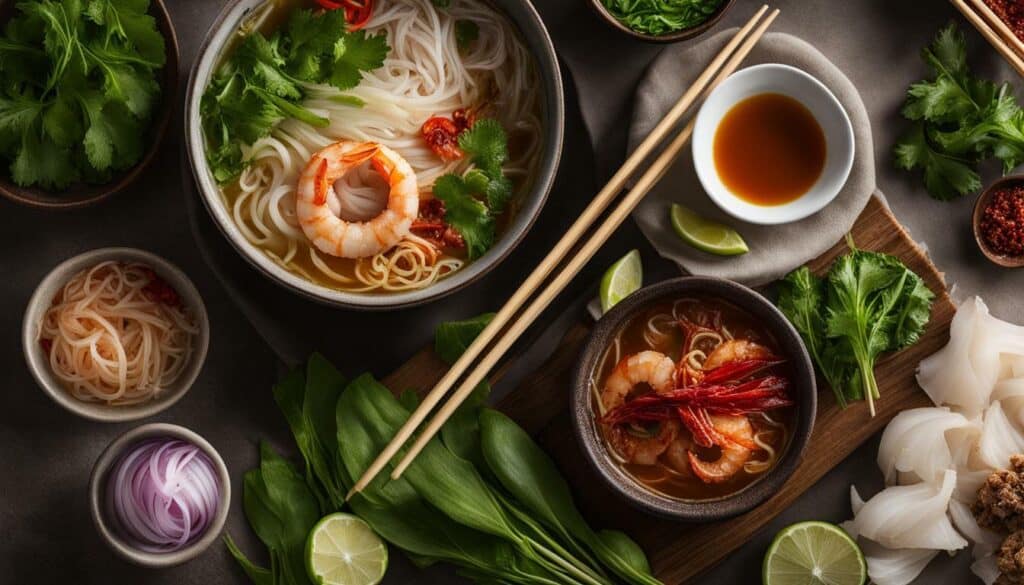
Pho is truly a culinary masterpiece, and the inclusion of Vietnamese dried shrimp and squid is just one example of the intricate flavors and hidden elements that contribute to its allure. Whether enjoyed in its traditional form or with personal variations, the use of these ingredients adds complexity and depth to the dish, making it a beloved favorite among food enthusiasts worldwide.
Adding Depth: Daikon, Cabbage, and Chayote
To create a well-rounded pho, authentic recipes often feature the inclusion of daikon, cabbage, and chayote. These vegetables bring a unique flavor and texture to the dish, enhancing its overall depth and complexity.
Daikon, also known as white radish, is a popular ingredient in Vietnamese cuisine. Its crisp and mildly spicy taste adds a refreshing element to the pho broth. When thinly sliced, daikon provides a delightful crunch that contrasts with the tender meat and silky noodles.
In addition to daikon, cabbage is another vegetable commonly found in pho recipes. Its slightly sweet and earthy flavor pairs well with the savory broth, offering a subtle sweetness that balances out the richness of the dish. Cabbage also adds a satisfying crunch, adding another layer of texture to the soup.
Chayote, often referred to as a vegetable pear, is a versatile ingredient that can be found in various Vietnamese dishes, including pho. Its mild, cucumber-like flavor adds a refreshing touch to the broth. Chayote’s tender texture complements the other ingredients, making it a delightful addition to the soup.
| Vegetable | Flavor | Texture |
|---|---|---|
| Daikon | Crisp, mildly spicy | Crunchy |
| Cabbage | Slightly sweet, earthy | Crunchy |
| Chayote | Mild, cucumber-like | Tender |
Including daikon, cabbage, and chayote in your pho not only adds complexity to the flavor profile but also introduces a vibrant assortment of colors to the dish. These vegetables not only enhance the taste but also contribute to the overall appeal of the soup.

“The combination of daikon, cabbage, and chayote in pho creates a harmonious balance of flavors and textures, elevating the dish to a whole new level of deliciousness.” – Pho enthusiast
By carefully selecting and preparing the right ingredients, pho enthusiasts and chefs alike can ensure that their broth is rich, flavorful, and well-balanced. The inclusion of daikon, cabbage, and chayote is just one example of the attention to detail that goes into creating an authentic pho recipe.
Variations of Pho: Beef and Chicken
While the secret ingredients remain consistent, pho offers delightful variations in the form of beef and chicken. These variations showcase the versatility of pho as a dish and allow for different flavor profiles to be enjoyed. Whether you prefer the rich and robust taste of beef or the lighter and more delicate flavor of chicken, there is a pho variation that will tantalize your taste buds. In beef pho, the broth is typically made by simmering beef bones for several hours, resulting in a deep and savory flavor. The beef is usually thinly sliced and added to the broth, along with rice noodles and a variety of toppings. The combination of tender beef, aromatic spices, and hearty broth creates a truly satisfying meal. On the other hand, chicken pho offers a lighter alternative. The broth is made by simmering chicken bones, lemongrass, and other aromatics. The result is a fragrant and delicate broth that pairs perfectly with the tender chicken and rice noodles. Chicken pho is often topped with fresh herbs, bean sprouts, and lime wedges, adding a refreshing and zesty element to each bite. Whether you choose beef or chicken pho, the key to an authentic recipe lies in the careful selection and preparation of ingredients. The broth should be rich and flavorful, the meat tender and succulent, and the noodles perfectly cooked. With the right combination of ingredients and a dash of culinary expertise, you can recreate the authentic flavors of pho in your own kitchen.Beef Pho Recipe
To give you a taste of the beef pho experience, here is a simple recipe that you can try at home:Ingredients:With this recipe, you can create a delicious bowl of beef pho that rivals any restaurant version. The secret ingredients and traditional cooking techniques will transport you to the vibrant streets of Vietnam, where the aroma of pho fills the air.Instructions:
- Beef bones
- Beef brisket or steak, thinly sliced
- Rice noodles
- Star anise
- Cinnamon sticks
- Charred ginger and onion
- Fish sauce
- Bean sprouts
- Thai basil
- Lime wedges
- In a large pot, simmer the beef bones with star anise, cinnamon, ginger, and onion for several hours to create a flavorful broth.
- Cook the rice noodles according to the package instructions and set aside.
- Thinly slice the beef brisket or steak.
- Prepare the toppings by washing and chopping the bean sprouts, Thai basil, and lime wedges.
- When ready to serve, divide the cooked noodles between bowls and top with the sliced beef.
- Ladle the hot broth over the noodles and beef.
- Garnish with bean sprouts, Thai basil, and a squeeze of lime.
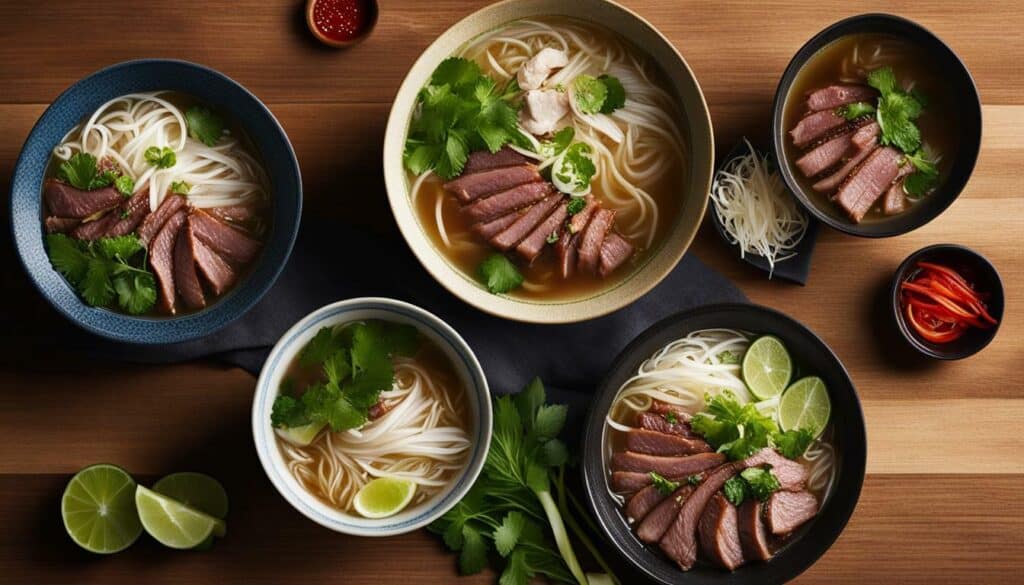 This image showcases the enticing variations of pho, with bowls of beef and chicken pho beautifully presented. The colors, textures, and flavors showcased in this image truly capture the essence of pho and its appeal to food enthusiasts around the world.
In conclusion, pho is not only a comforting and delicious dish, but also a culinary masterpiece that has stood the test of time. The secret ingredients and authentic recipes passed down through generations are what make pho truly special. So whether you prefer the richness of beef pho or the lightness of chicken pho, there is no denying the allure of this beloved Vietnamese delicacy.
This image showcases the enticing variations of pho, with bowls of beef and chicken pho beautifully presented. The colors, textures, and flavors showcased in this image truly capture the essence of pho and its appeal to food enthusiasts around the world.
In conclusion, pho is not only a comforting and delicious dish, but also a culinary masterpiece that has stood the test of time. The secret ingredients and authentic recipes passed down through generations are what make pho truly special. So whether you prefer the richness of beef pho or the lightness of chicken pho, there is no denying the allure of this beloved Vietnamese delicacy.
Pho is traditionally served with rice noodles and an array of toppings that enhance the overall taste experience. The rice noodles used in pho are flat and tender, providing a delicate texture that pairs perfectly with the rich broth. These noodles are typically made from rice flour and water, giving them a light and slightly chewy consistency.
When it comes to toppings, pho offers endless possibilities to customize each bowl according to personal preferences. Bean sprouts, Thai basil, and lime wedges are commonly served alongside pho, adding crispness, freshness, and tanginess to the dish. The bean sprouts provide a refreshing crunch, while the Thai basil adds an aromatic note. Squeezing fresh lime juice over the bowl not only adds acidity but also brightens up the flavors of the broth.
To further elevate the taste, additional condiments can be added to pho. Hoisin sauce, a sweet and savory sauce made from soybeans, sugar, and spices, is often drizzled over the noodles and broth, imparting a rich and slightly sweet flavor. Sriracha, a hot chili sauce, can also be added for those who prefer a bit of heat in their pho.
| Rice Noodles | Toppings |
|---|---|
| Flat and tender texture | Bean sprouts for crunch |
| Light and slightly chewy | Thai basil for aroma |
| Made from rice flour and water | Lime wedges for tanginess |
Favorite Toppings
- Hoisin sauce for sweetness
- Sriracha for heat
The Art of Making Pho from Scratch
Making pho from scratch is a labor of love that involves meticulously simmering meat, bones, and secret ingredients to create a flavorful broth. Traditional pho recipes call for a combination of beef bones and spices like star anise and cinnamon, which infuse the broth with their aromatic essence. The process starts by charring ginger and onion, which adds depth to the flavor profile. This technique helps bring out the natural sweetness of the ingredients and create a rich, savory base for the soup.
Once the broth is prepared, it’s time to enhance the flavor even further by adding Vietnamese dried shrimp and squid. These ingredients lend a unique seafood undertone to the pho, elevating its taste to new heights. To add texture and crunch, daikon, cabbage, and chayote are added to the mix. These vegetables not only provide nutritional value but also contribute to the overall taste experience of the dish.
When it comes to making pho, it’s crucial to choose the right cuts of meat and bones. Simmering them for several hours allows their flavors to meld with the spices and aromatics, resulting in a broth that is both rich and comforting. The combination of beef bones and fish sauce provides the umami essence that is characteristic of authentic pho. This complex broth forms the foundation of the dish, and it is the secret behind its irresistible flavor.
| Secret Ingredients | Role |
|---|---|
| Star anise and cinnamon | Create an aromatic profile |
| Charred ginger and onion | Add depth and richness |
| Beef bones and fish sauce | Contribute to the umami essence |
| Vietnamese dried shrimp and squid | Enhance the flavor with a seafood undertone |
| Daikon, cabbage, and chayote | Provide texture and contribute to taste |
So, the next time you enjoy a bowl of pho, take a moment to appreciate the craftsmanship and dedication that goes into making it from scratch. From simmering the broth to selecting the perfect combination of ingredients, every step is essential in creating the unique flavors that make pho an enduring favorite.
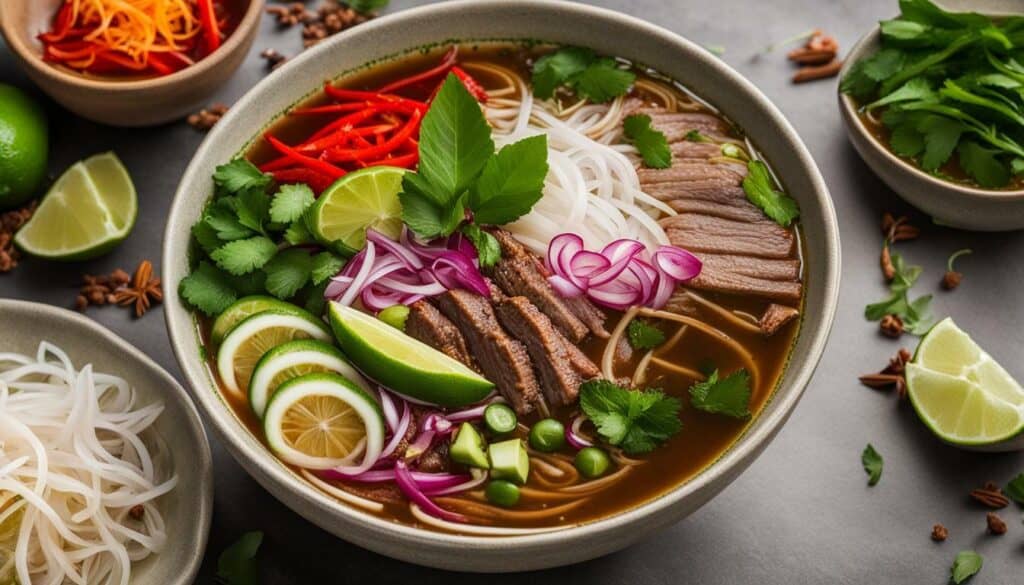
Pho’s secret ingredients and distinct flavors have propelled its popularity beyond Vietnam’s borders, capturing the hearts and taste buds of people around the world. This beloved Vietnamese noodle soup has become a global sensation, with pho restaurants popping up in major cities and food enthusiasts seeking out authentic pho recipes.
What makes pho so special? It’s the combination of carefully selected ingredients and the artistry in preparing the broth. The secret spices of star anise and cinnamon lend a warm and aromatic note, creating that iconic pho fragrance. The flavors are further enhanced by the charred ginger and onion, which add a depth and richness to the broth.
But it doesn’t stop there. The essence of pho lies in the beef bones and fish sauce, which contribute to its umami-packed broth. Vietnamese dried shrimp and squid are also used to elevate the flavor profile, imparting a unique seafood undertone. Vegetables like daikon, cabbage, and chayote add freshness and texture to the dish.
To create the perfect pho broth from scratch, it requires patience and expertise. Handling a large amount of meat and bones is necessary to achieve a rich and flavorful base. Simmering them with spices and aromatics for several hours is the secret behind a truly authentic pho.
Pho is typically served with rice noodles and an array of toppings such as bean sprouts, Thai basil, and lime wedges. These accompaniments add freshness, crunch, and a burst of freshness to each spoonful.
Table: Variations of Pho
| Pho Type | Key Ingredients |
|---|---|
| Beef Pho | Beef bones, star anise, cinnamon, ginger, onion, fish sauce |
| Chicken Pho | Chicken bones, star anise, cinnamon, ginger, onion, fish sauce |
Pho’s global popularity can be attributed to its intricate flavors, comforting qualities, and the sense of cultural immersion it provides. Whether you’re in Vietnam or halfway across the world, a steaming bowl of pho is a culinary experience that transcends borders and brings people together.
Unveiling the Secrets Behind Pho’s Unique Flavor
Pho’s secret ingredients, including star anise, cinnamon, charred ginger and onion, beef bones, and fish sauce, come together to create an unparalleled flavor that has made this Vietnamese delicacy a beloved culinary treasure. Each component plays a crucial role in developing the aroma, depth, and complexity of the broth, resulting in a comforting and satisfying bowl of noodle soup.
Star anise and cinnamon, the key spices in pho, impart their warm and fragrant notes that are characteristic of this dish. These spices are carefully balanced to achieve the perfect aromatic profile, elevating the overall experience of enjoying a bowl of pho.
To enhance the flavor, ginger and onion are charred, bringing out their natural sweetness and creating a rich foundation for the broth. The charred bits infuse the soup with a smoky undertone, adding depth and complexity to each spoonful.
The essence of pho lies in the combination of beef bones and fish sauce. The long hours of simmering extract the umami goodness from the bones, resulting in a rich and flavorful broth. The addition of fish sauce, a staple in Vietnamese cuisine, enhances the savory profile, giving pho its distinctive taste.
But the secret ingredients don’t stop there. Vietnamese dried shrimp and squid are often added to bring a subtle seafood flavor to the soup, adding an additional layer of complexity. Daikon, cabbage, and chayote contribute to the overall taste and texture, lending a fresh and crunchy element to the dish.
There are variations of pho, such as beef and chicken, each showcasing the secret ingredients in their own unique way. Served with rice noodles and an array of toppings, such as bean sprouts, Thai basil, and lime wedges, pho becomes a customizable culinary experience.
The art of making pho from scratch involves patience and technique. Handling a large amount of meat and bones, simmering them with spices and aromatics for hours, results in a broth that is deeply flavorful and satisfying. This traditional process is what sets authentic pho apart from other imitations.
Pho’s global popularity and enduring appeal can be attributed to the harmonious blend of secret ingredients and the captivating flavors they create. From the streets of Vietnam to kitchens around the world, pho continues to delight and tantalize taste buds with its unique and comforting qualities.
So, the next time you savor a bowl of pho, take a moment to appreciate the secret ingredients that make it truly special. Let the aroma waft around you, the flavors dance on your palate, and be transported to the streets of Vietnam with each delicious spoonful.
FAQ
Q: What are the secret ingredients in pho that make it unique?
A: The secret ingredients in pho include star anise, cinnamon, charred ginger and onion, beef bones, and fish sauce. These elements contribute to the distinct fragrance and taste of this Vietnamese noodle soup.
Q: What other ingredients can enhance the flavor of pho?
A: Other ingredients that can enhance the flavor of pho include Vietnamese dried shrimp, dried squid, daikon, cabbage, and chayote. These additions add depth and complexity to the soup.
Q: What is the key to a good pho broth?
A: The key to a good pho broth is using the right combination, proportion, and technique. Simmering meat and bones with spices and aromatics for several hours is crucial in creating a flavorful broth.
Q: Are there variations of pho?
A: Yes, there are variations of pho, including beef and chicken. The secret ingredients mentioned earlier can be adapted to create different flavors of pho.
Q: What are the essential accompaniments to pho?
A: The essential accompaniments to pho include rice noodles and various toppings such as bean sprouts, Thai basil, and lime wedges. These components complement the flavors of the broth.
Q: How do you make pho from scratch?
A: Making pho from scratch involves handling a large amount of meat and bones, simmering them with spices and aromatics for several hours to create a flavorful broth.
What Are the Common Ingredients in a Stir-fry That Differentiate It from Pho?
Stir-fry and pho are two distinct Asian dishes that have different common ingredients. While stir-fry typically includes vegetables, protein, and a sauce, pho features rice noodles, broth, spices, and herbs. The common ingredients in stir-fry lend it a savory and crispy taste, while pho’s combination creates a rich and aromatic soup.


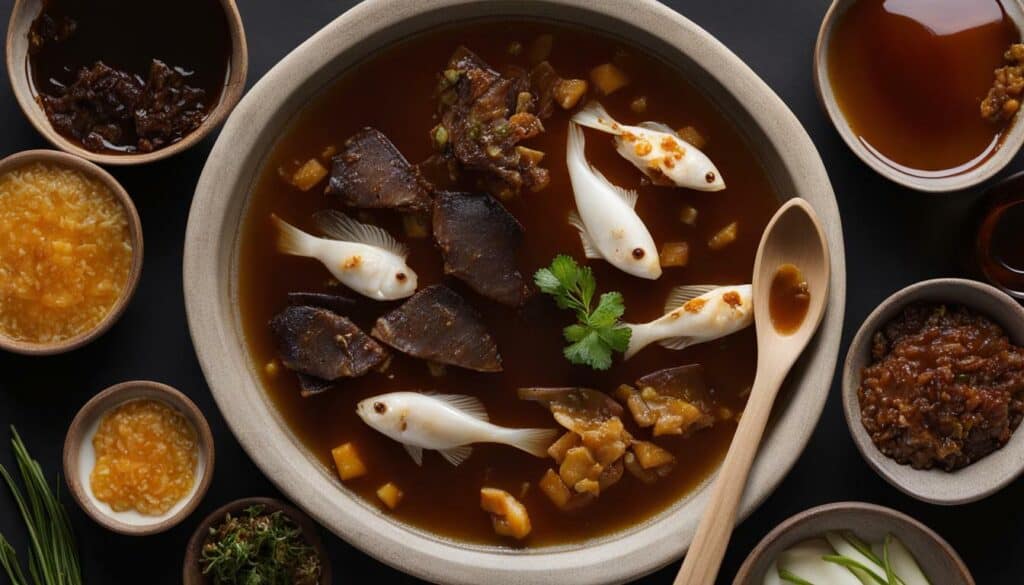
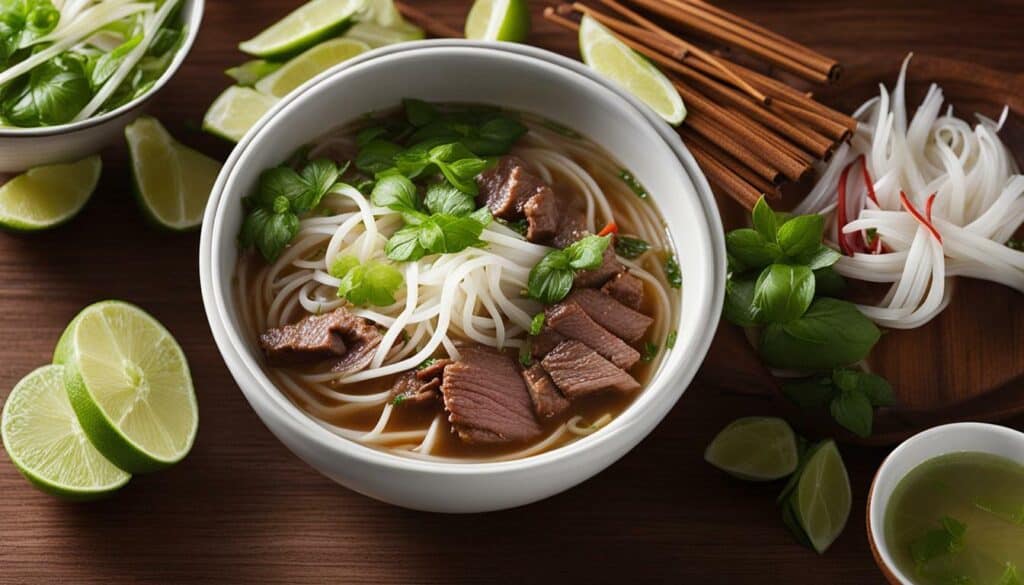
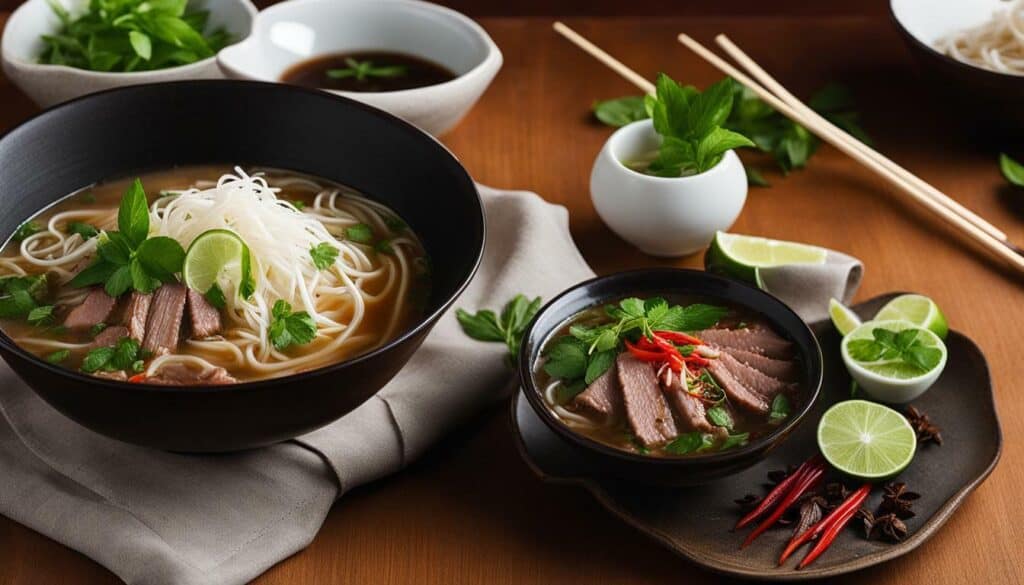



Leave a Reply